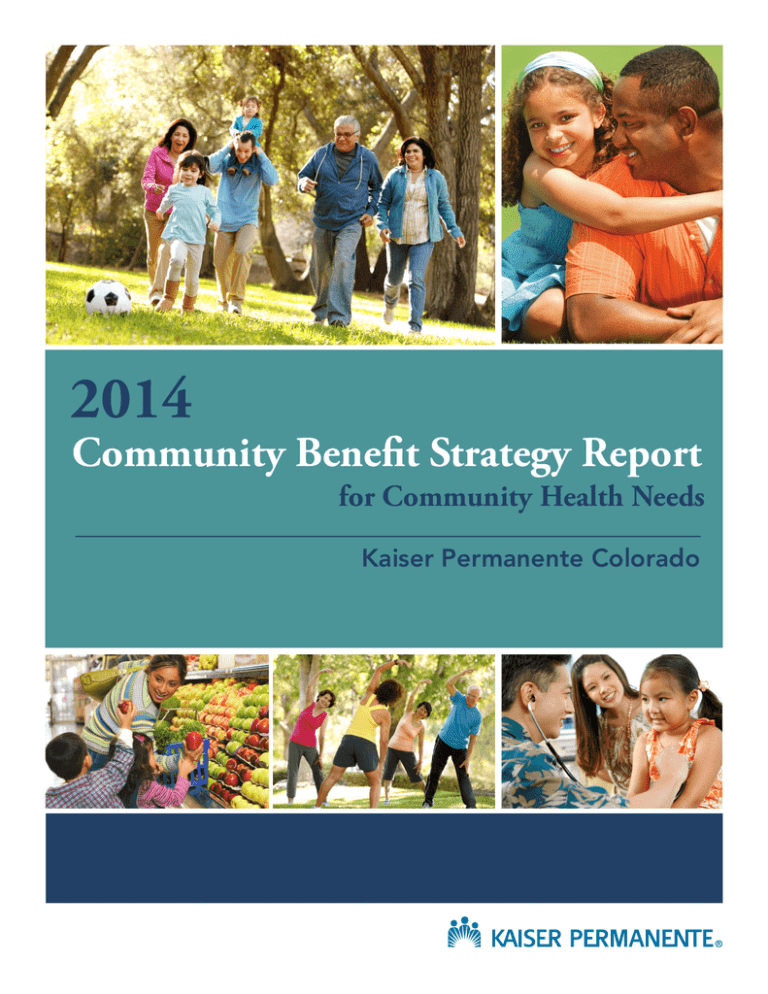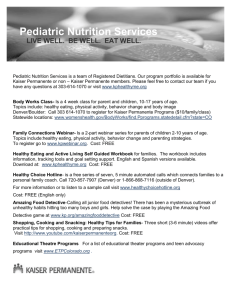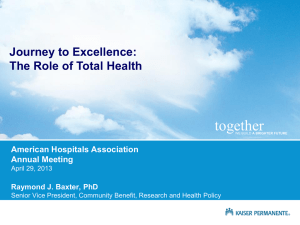2014 Community Benefit Strategy Report for Community Health Needs
advertisement

2014 Community Benefit Strategy Report for Community Health Needs Kaiser Permanente Colorado Kaiser Permanente Colorado 2014-2016 Community Benefit Strategy Summary I. About Kaiser Permanente Colorado Kaiser Permanente is the state’s largest nonprofit health plan, proudly working to improve the lives and health of Colorado residents for 45 years. We provide comprehensive health care services to more than 615,000 members through 28 medical offices and a network of affiliated hospitals and physicians. The health plan was named “Highest in Member Satisfaction” among Commercial Health Plans by J.D. Power and Associates for the seventh straight year. Kaiser Permanente was recognized by the National Committee for Quality Assurance (NCQA) as the top- ranked commercial health plan in Colorado and the fourth ranked Medicare plan in the nation. We were also recently recognized as a 2012 Hypertension Champion by Million Hearts™. For more Kaiser Permanente news, visit kp.org/share or follow us on Twitter @kpcolorado or facebook.com/kpcolorado. Kaiser Permanente Community Benefit We believe good health is a fundamental right shared by all and we recognize that wellness extends beyond the doctor’s office and the hospital. It begins with healthy environments, which we define as fresh fruits and vegetables in neighborhood stores, successful schools, clean air, accessible parks, safe playgrounds, etc. These are vital signs of healthy communities. Good health for the entire community, which we call Total Community Health, requires equity and social and economic wellbeing. Much like our approach to medicine and health care, our work in the community takes a preventionfocused, evidence-based approach. We see the big picture when it comes to fostering wellness because we know individual health outcomes are influenced by personal behaviors and social and environmental factors. We go beyond traditional corporate philanthropy or grant funding to pair financial resources with medical research, physician expertise, and clinical practices. So we work closely with community health centers, public hospitals, and health departments supporting their efforts to provide care for the uninsured, underinsured, and underserved with infrastructure, training, expertise, grants, and equipment. Our own programs also lower financial barriers. And our employees also generously give their time, talents, and passion for the benefit of the community. Kaiser Permanente Colorado Service Area We define our service area broadly, including 23 counties. Sixteen counties are classified as urban, five as rural and two as frontier, according to the Colorado Department of Public Health and Environment. Rural counties in the western section of the region lie in the Rocky Mountains and surrounding foothills while rural counties in the eastern section are on Colorado’s Eastern Plains. Major cities within the region include Aurora, Colorado Springs, Denver and its surrounding metro area, Fort Collins and Pueblo. Although most of our membership lives in those counties that have, or are adjacent to, our medical offices, we included sparsely populated counties in our service area to better understand the regional issues and needs impacting all community members. 1|Page 101514 Our service area includes 86 percent of the Colorado population. Approximately 83 percent of the community identifies as white and just over 13 percent of the community identifies as black, some other race or multiple races. More than 20 percent of the community identifies as ethnically Hispanic. The community has a higher rate of “linguistically isolated” populations, or individuals aged five (5) and older who speak a language other than English at home and speak English less than “very well,” than the state overall. Adams County has the highest rate (14.17 percent) of “linguistically isolated” populations, nearly double the state rate. More than 60 percent of the community lives in an area designated as a health professional shortage area, which means the geographic area has a shortage of primary medical care, dental, and/or mental health professionals. II. Public Health Issues For many years, we have worked collaboratively with community organizations to address serious public health issues such as obesity, access to health care, and violence. In 2013, we conducted a Community Health Needs Assessment (CHNA) to better understand the community’s unique needs and resources. The Colorado Health Institute, serving as our consultant on the CHNA, incorporated information on health needs from a wide range of sources. Our common data platform, pre-populated with common indicators on demographics, health outcome and other health factors data, served as a main resource. Regional data on health outcomes and other issues that influence health, such as social and economic factors and health behaviors, were collected. Community and public health input was gathered through existing state priorities, such as Colorado’s Ten Winnable Battles, through local nonprofit hospitals, and through local public health agency community assessment and prioritization plans. The CHNA process guides our community investments and helps us develop strategies aimed at making long-term, sustainable change, which allows us to deepen the strong relationships we have with other organizations that are working to improve community health. Through this process we identified the following significant health needs in the communities we serve: 2|Page • Access to Primary Care and Primary, Secondary, and Tertiary Prevention Services. Coloradans need access to comprehensive and continuing primary medical care and primary prevention services that prevent disease, secondary prevention services that diagnose and treat disease in early stages, and tertiary prevention services that reduce disease-related complications and help patients fully function. • Healthy Eating and Active Living. Coloradans need access to affordable, healthy food and the opportunity to lead physically active lifestyles. • Mental Health and Substance Abuse Support. Coloradans need access to services that address poor mental health and substance abuse as well as services that support social and emotional wellness. 101514 • Economic Opportunity. Coloradans need the tools and resources, including education, health insurance, and family and community supports, to achieve economic self-sufficiency and to lead healthy lives. III. Community Benefit Strategy Summary We applied a criteria-based decision making process to examine and address the list of health needs, select the community health needs to address, and develop a strategic plan to address those health needs. Health needs arise from the comprehensive identification, interpretation, and analysis of a robust set of primary and secondary data. We’ll continue to build upon our assets and resources, as well as evidence-based strategies, to focus primarily on the following two health needs: Access to Primary Care and Prevention Services (Primary, Secondary, and Tertiary ) and Healthy Eating and Active Living. It is understood that these include Mental Health and Substance Abuse. Additionally, our strategies provide opportunities to address Economic Opportunity issues within underserved communities and populations. 1) Health Need Access to Primary Care and Prevention Services is a health need to prevent physical and mental health diseases, diagnose and treat disease in early stages, reduce disease-related complications and help individuals fully function. a) Long Term Goal Increase access to comprehensive and continuing primary medical care and primary prevention services to prevent disease, diagnose and treat disease in early stages, and reduce disease-related complications for individuals to help them function to their highest potential and gain the social and economic resources essential to overall health. b) Intermediate Goals & Strategies i) Increase the number of low-income individuals who enroll in, or maintain, health care coverage. Strategy: Participate in subsidized coverage programs for low-income individuals such as Medicaid and Charitable Health Coverage programs. ii) Increase the number of low-income individuals who have access to quality health care and prevention services including mental health and substance abuse. 3|Page 101514 Strategies: • • • • • Provide information about and access to Medical Financial Assistance programs that provide economic and social support resources and lower financial barriers to physician and behavioral health services. Partner with safety net clinics such as Community Health Centers or free clinics, specialty care departments, and community partners to create community solutions that address access to integrated, specialty care for low-income patients. Grant funding and provide resources to build capacity among Community Health Centers and other safety net clinics including community behavioral health providers, supporting associations, and community organizations that promote economic opportunity. Provide resources, contracts, and grant funds to Community Health Centers, other safety net clinics, and community partners to increase availability and dissemination of evidence- based care management, quality improvement and behavior change programs such as Diabetes Prevention Program, ALL (aspirin, lisinopril, lipidlowering medication) program, Stanford Chronic Disease Self-Management, and National Committee for Quality Assurance certification for Medical Home designation. Collaborate with community partners to conduct community-focused research to identify behavioral health concerns and share effective, community-appropriate prevention and treatment interventions. iii) Create a high quality, culturally competent clinical and community health workforce. Strategies: • • Provide health care equity training programs (e.g., Care Equity Project, Diversity videos, etc.) to community care providers and higher education partners. Provide grant funding and direct support for knowledge dissemination through research, conferences, presentations and Continuing Medical Education to build greater capacity for health care and public health. iv) Expand the clinical and community health workforce. Strategies: • • • 4|Page Provide grant funding and direct support for career development in health care programs Expand economic opportunity for diverse people through diversity health scholarships and workforce grants, etc. Provide internal resources and support to train the next generation of the health care workforce through precepting and student education programs. 101514 v) Increase the number of school health initiatives that support access to care and prevention services and promote health and academic success. Strategy: Collaborate with school-based health providers, state, and regional school networks and provide resources such as financial contributions, and internal resources and expertise, and/or contracts. 2) Health Need Healthy Eating and Active Living (HEAL) is a health need because when people have access to healthy food, safe neighborhoods, fresh water, and clean air they’re more likely to be healthy. This directly impacts health concerns including, cancer, obesity, cardiovascular disease, diabetes, and mental health/substance use issues. a) Long Term Goal Increase access to affordable, healthy foods, expand opportunities to lead physically active lifestyles, and build economically vibrant communities. b) Intermediate Goals & Strategies i) Increase the number of policies, community programs and social and economic resources to support and promote healthy eating. Strategies: • • • • Collaborate with state and regional networks and coalitions to develop policies and programs that increase access to healthy, nutritious food resources. Grant funding to make healthy, nutritious food options available and accessible in public places with a focus on food-insecure populations. Grant funding to increase nutrition information and education for low-income families and caregivers. Provide support to hunger and food system focused nonprofit organizations with resources such as employee community service and in-kind donations. ii) Increase the number of policies, community programs, and social and economic resources that support and promote physical activity. Strategies: • • 5|Page Collaborate with state and regional networks and coalitions to increase access to safe, multi-modal transportation. Grant funding to communities to develop safe, economically vibrant, livable environments that support walking and biking and foster access to, promotion of and demand for more livable communities that support walking and wheeling (e.g., 101514 biking, skateboarding) for daily activities (jobs, schools, health, other essentials); including support for community organizations that promote economic opportunity and advancement to help individuals, families, and communities overcome economic barriers to HEAL. iii) Support school initiatives that address health factors to support learning and educational achievement. Strategies: • • • • • 6|Page Grant funding to increase access to daily recommended levels of physical activity before, during, and after school. Provide health education and messaging to schools through Educational Theatre Programs with a focus on healthy eating, active living and behavioral health through social and emotional wellness. Grant funding to organizations that implement evidence-based efforts to address school climate and behavioral health (i.e., student social and emotional wellness). Collaborate with state and regional networks and coalitions to advance youth engagement and advocacy. Grant funding and collaboration with state and regional agencies and organizations to improve school health indicator data systems. 101514



